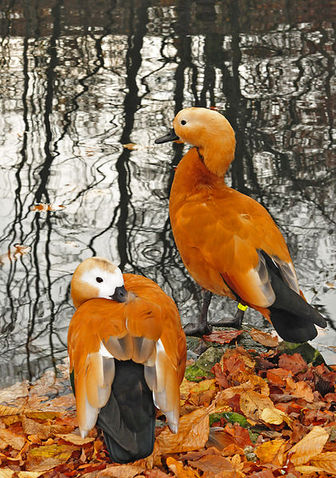Ruddy shelduck
The Ruddy Shelduck, Tadorna ferruginea, is a member of the duck, goose and swan family Anatidae. It is in the shelduck subfamily Tadorninae. In India it is known as the Brahminy Duck.

Original source: Own work
Author: Michael GäblerOther versionsFile:A couple of Tadorna ferruginea.2.jpg
The Ruddy shelduck is classified as Least Concern. Does not qualify for a more at risk category. Widespread and abundant taxa are included in this category.
The Ruddy Shelduck, Tadorna ferruginea, is a member of the duck, goose and swan family Anatidae. It is in the shelduck subfamily Tadorninae. In India it is known as the Brahminy Duck. There are very small resident populations of this species in north west Africa and Ethiopia, but the main breeding area of this species is from south east Europe across central Asia to southeast China. These birds are mostly migratory, wintering in southern Asia. More
The Ruddy Shelduck is usually found in pairs or small groups and rarely forms large flocks. However, moulting and wintering gatherings on chosen lakes or slow rivers can be very large. The Ruddy Shelduck is a distinctive species, 58 More
Sometimes confused with the Ruddy Shelduck, drakes have a gray head and neck with buff breast. The rest of the body is chestnut red, similar to the Ruddy. Hens are close in appearance to the drake, but have a white face surrounded by a darker brown head. There are many ornithologists that believe the Cape Shelduck is in fact a subspecies of the Ruddy, due in large part to their similar appearance and habits. Their care in captivity is nearly identical to the Ruddy. More
Ruddy Shelducks breed in a broad band from Morocco, through most of central Asia to china. Many birds are year round residents of the breeding range, but some winter in the Nile valley, India and south-east Asia. There are even reports of stragglers to the United Kingdom and North America, but these may be escaped aviary birds. More
the Ruddy Shelduck is still common across much of its Asian range. It may be this population which gives rise to vagrants as far west as Iceland and Great Britain. However, since the European population is declining, it is likely that most occurrences in western Europe in recent decades are escapes or feral birds. Although this bird is observed in the wild from time to time in eastern North America, no evidence of a genuine vagrant has been found. More
Ruddy shelduck standing in shallow water© Eric Baccega / naturepl.com A pair of ruddy shelducks in shallow water© Jagdeep Rajput / www.ardea.com Ruddy shelduck sleeping© Eric Baccega / naturepl.com Ruddy shelduck stretching wings© Jagdeep Rajput / www.ardea.com Ruddy shelduck swimming© Rico and Ruiz / naturepl.com Ruddy shelduck taking off from the water© Jagdeep Rajput / www.ardea. More
In Tibet and Mongolia, Ruddy Shelduck is considered sacred by the Buddhists. It is also a sacred animal in Slavic mythology. In Hindi and Urdu (India/Pakistan) it is called Surkhab. The genus name Tadorna comes from Celtic roots and means "pied waterfowl", essentially the same as the English "shelduck". The Ruddy Shelduck is one of the species to which the Agreement on the Conservation of African-Eurasian Migratory Waterbirds (AEWA) applies. More
The ruddy shelduck is native to central and eastern Asia, living in various regions inland often around lagoons, lakes, marshes, rivers and streams. It is regularly found in hills up to 5,000m. Taxonomy Like all living organisms, the ruddy shelduck is classified according to its physical characteristics. This is known as its taxonomy. More
For the purposes of our bird news services, Ruddy Shelduck is classed as Scarce: broadly speaking, species that are covered in British Birds' annual review of scarce species (and forms of similar rarity). More
Aspects of the topic ruddy shelduck are discussed in the following places at Britannica. Assorted References * species of shelduck (in shelduck (duck group)) ...shelduck (Tadorna tadorna) of Europe and Asia is black and white with a reddish chest band; the drake has a knob on its red bill. More
Ruddy Shelduck in to this country accepted to be all wild birds, thought to be caused by a particularly dry spring in eastern Europe driving the birds westward(1). Apparently there were several flocks of up to 20 birds that year but no record of any reaching the Dee Estuary, the nearest being one shot on the Mersey Estuary(2). Reports of Ruddy Shelduck up to 1985 were sparse, to say the least. More
The majority of Ruddy Shelducks in the UK are unlikely to be genuine wild vagrants from their native range. Escapes from captivity are frequent and these account for a number of sightings. However small influxes of this species appear each autumn, usually involving immature birds, and it now seems likely that these derive from an burgeoning feral population which exists in Continental Europe. More
Ruddy Shelducks have a very loud call that can be heard from quite a distance. Males honk, almost like a goose and hens make a louder 'Ka-ha-ha'. They do very well in captivity, but require a larger aviary than other species of waterfowl. They are very hardy and can withstand very cold temperatures. Copyright More
The ruddy shelduck is a medium-sized shelduck group with a body-weight of about 1.2 to 1.6 kg in males and 1 to 1.5 kg in females. The plumage is beautifully buff and cinnamon coloured with a glossy green speculum. The head is lighter than the body, and males usually have a narrow black collar. Bill, legs and feet are black. More

Original source: Jiří Bukovský
-Jiří Bukovský -Author: Jiří Bukovský
Permission: Some rights reserved
Family : Anatidae
Genus : Tadorna
Species : ferruginea
Authority : (Pallas, 1764)
